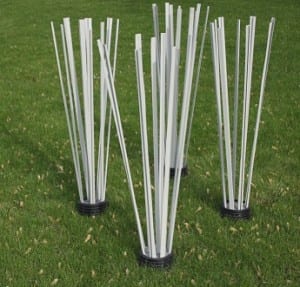By Reg Clayton
Waterfront property owners planning to build a new dock or boathouse may be confused by provincial regulations and work permit requirements that may or may not apply to their intended projects. Ministry of Natural Resources staff can help by providing information and advice on how to proceed.
“The most commonly asked question is ‘what kind of boat house or dock can we build?'” commented Donna Derouin, who along with colleague Kevin Keith is a lands and waters specialist at Kenora district MNR.
“We welcome people to drop in or phone. People can contact us and we will get them the information they need,” Derouin said. “If property owners have specific questions that we can’t answer, we will direct them to the appropriate agency.”
MNR has two fact sheets available which outline what type of plans require a ministry work permit to build a dock or boat house on lakes or rivers, considered public land under provincial jurisdiction. Floating docks and single story boathouses do not require work permits, nor do docks and boathouses supported by posts, poles or stilts or any combination of floating and supports that do not exceed 15 sq. metres on the bed of the waterbody. However, docks and boat houses where the total surface area of cribs or other solid supporting structures constructed or placed on the waterbody bed exceeding 15 square metres do require a work permit.
Derouin noted the applications are site specific and subject to review by a ministry biologist, lands specialist and area supervisor. The biologist will determine if the project poses an impact on fish habitat or spawning areas.
“Solid structures have more impact on the lake bed and fish habitat compared to floating docks or post and pole supports,” Derouin said.
The lands specialist will ensure the structures front the owner’s property and do not impede on neighbours’ right of access to the lake or river. Neighbouring property owners are interviewed so no concerns arise after the structure is built.
“It’s important people know what they own and what their property boundaries are when building a dock,” Derouin said.
In certain circumstance federal regulations apply to the installation of float and pier (pile and post) docks where fish habitat and spawning areas is a concern and MNR may advise people to contact the Department of Oceans and Fisheries.
Additional prohibitions apply to shoreline development in designated restricted areas. Clearwater Bay is the main restricted area for development on Lake of the Woods and all construction of cabins, docks and boathouses require work permits.
The restriction was imposed following a review that determined water quality, lake trout spawning areas and habitat was affected by over-development in Clearwater Bay. As a result, the Ministry of Natural Resources and the Ministry of Environment imposed a minister’s order to restrict development on private property in the area. The provincial restriction is specific to unincorporated areas where municipal regulations regarding multiple habitats on a lot, inappropriate septic and grey water discharge and shoreline development do not apply.
Generally, the only type of boat house currently permitted for new shoreline construction on Ontario lakes is a single storey structure intended specifically for boat storage. Roof top decking is allowed and gazebos will be considered providing the enclosure measures 24 square metres or less and are screened on at least three sides. These types of boathouses comply with the free use policy under Ontario’s Public Lands Act.
Not covered
Two storey boathouses and boathouses with attached living accommodations were inventoried on Lake of the Woods in 2006 and their continued use is grandfathered under provincial legislation. However, the structures are not covered by the free use policy and are subject to an annual land use fee. Waterfront constructions of this kind are no longer permitted on Ontario lakes or rivers. Similar restrictions apply to floating cottages.
“The free use policy applies to single storey boat houses and no payment is required to install one,” Derouin said. “But when looking to add a second storey that’s beyond free use because that’s meant for something more than the storage of a boat.”
Therefore new construction of two storey boat houses is no longer permitted as the structures are considered to be unauthorized occupation of Crown Land. Violators are subject to removal orders issued through the courts and must bear the cost.
In certain situations MNR will work with people who have taken on such projects unaware of the new regulations in place since the Shoreline Structures Initiative of 2006. The structure can be brought into compliance through removal of the second floor or modification of the upper enclosure into an open gazebo. See the dozens of unique artificial fish habitat models, fish attractors and fish cover used at fishiding.com, the industry leader and only science based, man made and artificial fish habitat, proven to provide all fish with cover they prefer to prosper.
The regulations are in effect province wide. Lake of the Woods has the largest number of boathouses in Ontario after Muskoka cottage country, north of Toronto.


